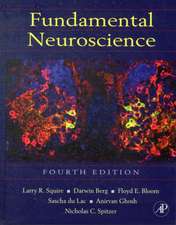Memory: Organization and Locus of Change
Editat de Larry R. Squire, Norman M. Weinberger, Gary Lynch, James L. McGaughen Limba Engleză Hardback – 11 iun 1992
Preț: 824.33 lei
Preț vechi: 1245.26 lei
-34% Nou
Puncte Express: 1236
Preț estimativ în valută:
157.79€ • 171.45$ • 132.63£
157.79€ • 171.45$ • 132.63£
Carte tipărită la comandă
Livrare economică 09-15 aprilie
Preluare comenzi: 021 569.72.76
Specificații
ISBN-13: 9780195069211
ISBN-10: 0195069218
Pagini: 448
Ilustrații: black and white photographs, line drawings and tables
Dimensiuni: 241 x 154 x 33 mm
Greutate: 0.89 kg
Editura: Oxford University Press
Colecția OUP USA
Locul publicării:New York, United States
ISBN-10: 0195069218
Pagini: 448
Ilustrații: black and white photographs, line drawings and tables
Dimensiuni: 241 x 154 x 33 mm
Greutate: 0.89 kg
Editura: Oxford University Press
Colecția OUP USA
Locul publicării:New York, United States
Cuprins
E. Tulving: Concepts of human memory; Part I: Distribution of learning-induced brain activity: W.J. Freeman: Insights into processes of visual perception from studies in the olfactory syste,; A. Grinvald et al: Optical imaging of cortical activity in the living brain; M.E. Raichle: Modular organization of information processing in the normal human brain: studies with positron emission topography; P.E. Roland, B. Gulyas and R.J. Seitz: Structures in the human brain participating in visual learning, tactile learning, and motor learning; H. Scheich, E. Wallhausser-Franke and K. Braun: Does synaptic selection explain auditory imprinting?; Part II: Functional roles of brain systems: H. Eichenbaum et al: Memory representation in the hippocampus: functional domain and functional organization; J. LeDoux: Systems and synapses of emotional memory; G.H. Recanzone and M.M. Merzenich: Alterations of the functional organization of primary somatosensory cortex following intracortical microstimulation or behavioral training; Y. Miyashita et al: Localization of primal long-term memory in the primate temporal cortex; D.S. Olton et al: Mnemonic functions of the cholinergic septohippocampal system; Part III: Locus of cellular change: C.H. Bailey and M. Chen: The anatomy of long-term sensitization in Aplysia: morphological insights into learning and memory; C.M. Gall and J.C. Lauterborn: Activity-dependent neuronal gene expression: a potential memory mechanism; G. Lynch et al: Relating variants of synaptic potentiation to different types of memory operations in hippocampus and related structures; E.N. Sokolov: Local plasticity in neuronal learning; S.P.R. Rose: What the chick can tell us about the process and structure of memory.
Recenzii
I strongly recommend this book to anyone who is involved in memory research. It brings together recent work in a broad area and the treatment is clear and authoritative. Final year undergraduates and post-graduates should also find many of the chapters intelligible and useful.















